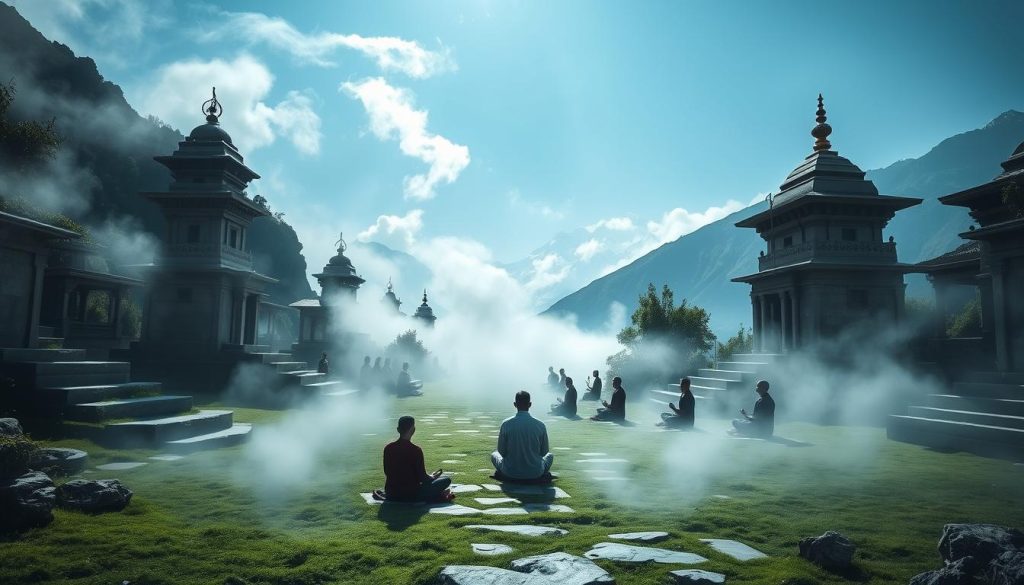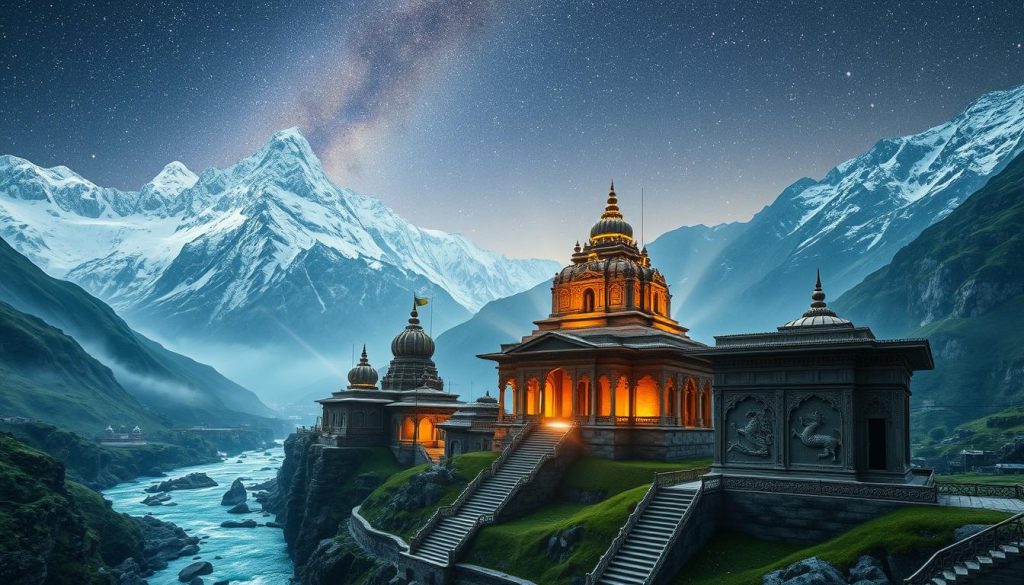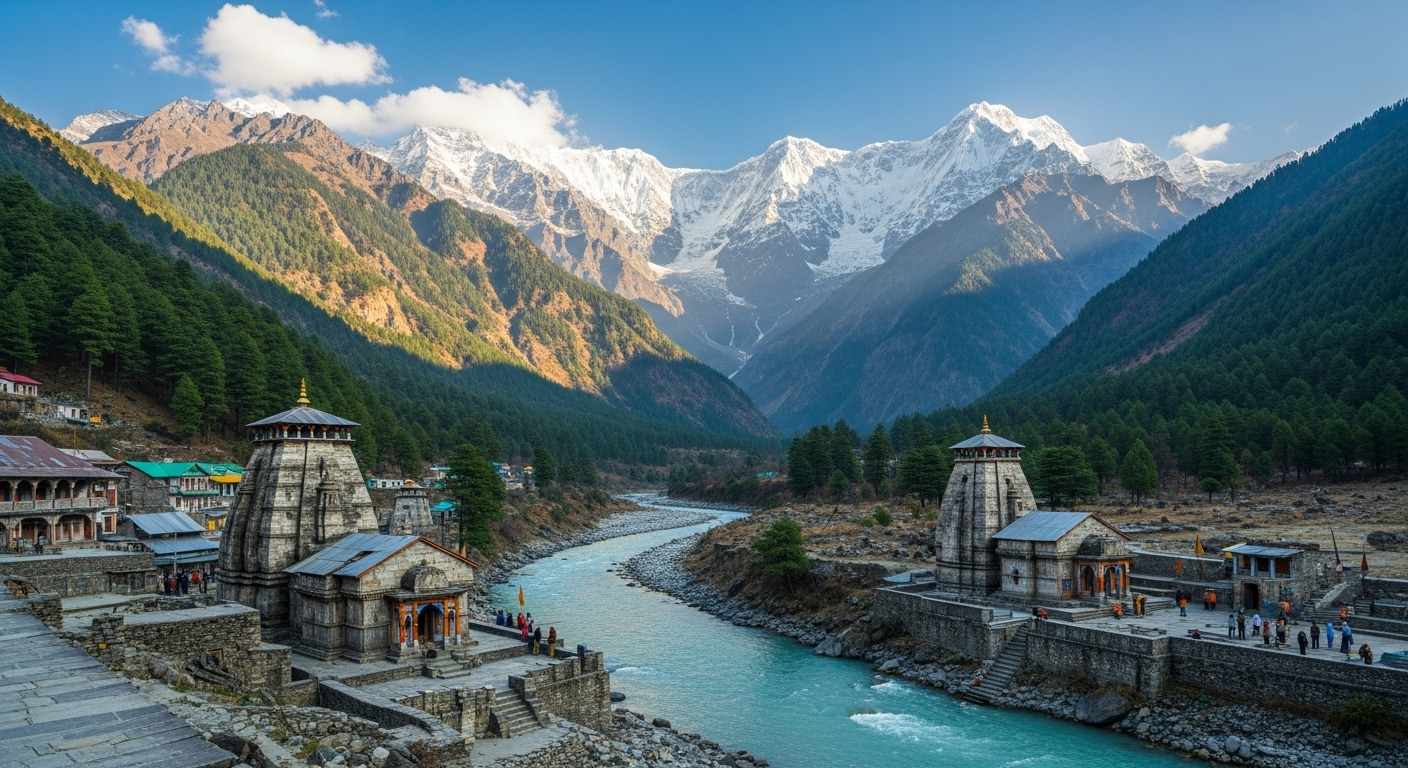Badrinath is a special name among Hindu pilgrimage sites. It is in Uttarakhand and is part of the Char Dham circuit. Along with Puri, Rameshwaram, and Dwarka, it draws people in. Ancient legends make Badrinath’s mystique. Devoted to Lord Vishnu, it attracts millions every year. They come to this place over 3,300 meters high for blessings.
The Badrinath Temple is surrounded by the Nar and Narayan mountain ranges. It touches those looking for spiritual strength. The temple has three parts: the Garbhagriha, Darshan Mandap, and Sabha Mandap. Here, visitors feel they are in a holy place, worshiping Lord Badrinath’s five forms.
The outsides of Badrinath are grand, but the secret stories are even more fascinating. In local markets, as people buy crafts and religious items, they walk into significant religious history. This is a spot praised in the Vedas and Upanishads. It’s a great place for spiritual practices.
Key Takeaways
- Badrinath is a key part of the Char Dham circuit and is very important in Hinduism.
- It has a mysterious past that enriches the experience of visitors.
- The design of the Badrinath Temple shows deep respect and holiness.
- Worship of Lord Badrinath’s five forms is central here, together with other gods.
- Local markets around Badrinath let visitors see the culture and find special items.
- Badrinath calls to pilgrims, historians, and nature lovers. They are drawn by its long-lasting legends.
The Spiritual Essence of Badrinath
Badrinath sits between the Nar and Narayan mountains. It’s more than a place; it’s a spiritual journey. It holds deep spiritual and historical importance. The founding myths and secrets of Badrinath show Hinduism’s mystical sides.
The Founding Myths and Ancient Legends
One famous tale is about Lord Vishnu meditating. He was protected from the cold by Goddess Lakshmi, as a Badri tree. This story gives Badrinath its name. It also highlights the gods’ sacrifices to keep the world balanced. These stories touch the hearts of those who visit, making their trip spiritually deep.
Sacred Geography: Between Nar and Narayan Peaks
Badrinath’s location between the Nar and Narayan peaks is special. This place connects the physical journey with the search for higher truth. The Nar and Narayan peaks are sacred. They represent Lord Vishnu’s divine forms, adding to Badrinath’s spiritual depth.
Badrinath’s charm comes from its myths, holy location, and spiritual acts. For pilgrims, it’s a path filled with stories and sacred sites from long ago. This makes visiting Badrinath a life-changing experience.
Unveiling the Lesser-Known Facts of Badrinath
People interested in Badrinath pilgrimage details find its history and spirituality captivating. Surrounded by mountains, the temple has three main parts. Each has a special role in its religious significance.
The Garbhagriha, or inner sanctuary, holds the revered idol. It attracts people worldwide for spiritual blessings. The Sabha Mandap is where people gather for religious talks. This underlines the Badrinath religious importance. The Darshan Mandap allows pilgrims to pray and see the deity.
- The temple’s rituals and beautiful design reveal many lesser-known facts Badrinath shares with visitors.
- Its daily rituals are old and sacred, making time spent here very special.
Lesser-known facts Badrinath impacts Hinduism deeply. It’s more than a place to visit. It’s a place to immerse in devotion and peace.
https://www.youtube.com/watch?v=N-0Ka2LBELg
Visiting Badrinath religious importance offers more than regular travel. It’s a spiritual quest. It shows Hindu rituals’ impact on life. Through seasons, Badrinath remains a faith symbol. Visitors discover its holy stories and leave enriched.
Hidden tales of Badrinath
The sacred town of Badrinath is nestled among the majestic Himalayas. It’s filled with divine tales and ancient mysticism. This section explores the spiritual and mythical stories that make Badrinath so important to the Hindu faith.
The Mystical Origins of the Badrinath Idol
The story of the Badrinath idol beginnings is truly fascinating. It involves gods and deep spirituality. Legend says Adi Shankaracharya found the idol of Lord Badrinarayan in the Alaknanda River in the 9th century. This black stone idol is a symbol of the divine tales Badrinath is famous for. People from around the world come here to find peace and a spiritual awakening.
Lakshmi’s Transformation: A Tale of Divine Love
Goddess Lakshmi became a berry tree to protect Lord Vishnu from the cold. He was meditating in the Himalayas. This story shows their strong bond. It also shows Goddess Lakshmi’s big role in making this place sacred. Because of her, Badrinath got its name from ‘badri’, the local word for berries.
The stories of the Badrinath idol and Goddess Lakshmi’s love are key. They make Badrinath not just a pilgrimage site. These tales inspire and lift the spirits of those who visit.
Architectural Wonders of Badrinath Temple
The Badrinath temple architecture is an ancient marvel. Every year, millions come to see its beauty. Surrounded by the peaceful Garhwal Himalayas, it connects people to the divine. Its complex design creates a special feeling.
Design Influences and Symbolic Significance
The temple’s design comes from old Vedic texts. It uses elements that show harmony in the universe. Sacred design Badrinath stands out for this. Adi Shankaracharya brought back this temple in the 8th century. This marked a new time for Hindu buildings. They now had geometric patterns and carvings of gods.
Sanctuary of the Gods: Inside the Garbhagriha
At the temple’s heart sits the Garbhagriha, or ‘womb-house’. It’s a special place with the main god, Lord Vishnu. Vishnu is shown in a peaceful pose. He is surrounded by symbols of cleaning for the soul and the universe. This room is very important for people looking for peace and blessings.
| Feature | Description | Spiritual Significance |
|---|---|---|
| Facade and Pillars | Carved from stone with intricate designs | Symbolizes eternal strength and resilience. |
| Garbhagriha | Innermost chamber housing Lord Vishnu’s idol | Centers the cosmic energy and serves as a meditative space for devotees. |
| Main Concourse | Wide area accommodating worshippers | Fosters communal worship and spiritual gatherings. |
The Badrinath temple is more than history and culture. It’s also a beacon for those on a spiritual quest. Its strong structure and holy design guide many. They come looking for spiritual help in the sacred Himalayas.
Badrinath Through the Ages: A Historical Perspective
The story of Badrinath is both spiritual and historically deep. Its ancient roots are woven with legends. Over the centuries, faithful pilgrims have kept its story alive. This shows Badrinath’s strong spirit and the devotion of those who visit.
To truly grasp Badrinath history, its role across Indian history must be noted. Known for its ancient prominence Badrinath has always been a light for those seeking spiritual guidance. Its location also made it key in the Char Dham pilgrimage. This has kept its importance in both stories and real spiritual practices.
Archaeology and old writings tell us how Badrinath has changed. Finding old objects and writings near the temple shows its rich cultural past. This proves Badrinath’s ancient prominence and secures its place in history.
Seasonal rituals show more of historical perspective Badrinath. The temple’s opening and closing ceremonies are ancient customs. They blend the spiritual with time-honored practices. These rituals are vital parts of Badrinath’s ongoing spiritual story.
Badrinath’s history is as lasting as the mountains around it. It shows the constant human search for the divine and for preservation. Through time, Badrinath remains a sacred site for many.
Mysterious Stories of Badrinath’s Enlightened Sages
The tales of Badrinath enlightened sages enrich its spiritual essence. They found peace here to meditate and gain wisdom. Their stories continue to inspire those who visit.
The Badrinath mystique comes from these mystics. Their hard spiritual work led to holy experiences and connections. This makes the place vibrant with spiritual life, loved by all.

Legends of superhuman acts and strict yogic practices fill the air. These stories enhance Badrinath’s holy atmosphere. They turn a visit into a deep spiritual healing journey.
A tale tells of a sage who meditated in the snow for hundreds of years. His focus was so strong that even mountains honored him. Such tales draw many, hoping to find peace and light here.
So, Badrinath isn’t just a temple town. It’s where spiritual learning and devotion shine. By honoring its sages, we join an ancient story of spirit and wonder. Here, every rock and river shares secrets of the divine.
###
Rituals and Ceremonies: The Path to Enlightenment
Badrinath is a spiritual town. It provides solace and engages visitors with rituals and festivals. These events have traditions that draw many pilgrims. They come for spiritual renewal and enlightenment.
The Daily Puja Schedule and Its Meaning
The daily Puja in Badrinath is very special. It happens throughout the day. These pujas start in the morning. They include many rites that bring out the divine energies from the temple. Each part of the puja, from morning blessings to evening aarti, has deep spiritual meaning. They cleanse the soul and help devotees on their spiritual journey.
Special Festivals and Events at Badrinath
Badrinath festivals are vibrant and full of meaning. The Badri Kedar Festival is very important. It lasts several days and includes cultural shows, talks, and gatherings. These festivals improve the community spirit. They also link ancient spiritual practices to the search for inner peace.
The table shows key festivals in Badrinath and what they mean:
| Festival | Date | Significance |
|---|---|---|
| Mata Murti Ka Mela | September | This festival honors the mother of Lord Badrinath on the auspicious day of Shravan Dwadashi, celebrating her contribution to Lord Badrinath’s mission on Earth. |
| Badri Kedar Festival | June | It encompasses cultural programs, spiritual discourses, and rituals at both Badrinath and Kedarnath, promoting the cultural heritage of Uttarakhand. |
Badrinath’s rituals and festivals keep the temple’s traditions. They also help devotees on their spiritual paths.
Enigmatic Tales of Badrinath in the Vedas and Puranas
Badrinath is a special place in India, known for its mystery. It’s mentioned a lot in old Hindu texts. These texts talk about its importance and spiritual meaning.
These writings cover Badrinath’s connection with gods, especially Vishnu. They tell stories that show how important it is for prayer and faith.
They include myths and stories of gods like Vishnu’s avatars, Rama and Krishna. These tales teach lessons on life and right from wrong.

The Puranas show Badrinath as a divine place, with Neelkanth Peak adding to its beauty. It’s key for spirituality and devotion.
Badrinath is also about wisdom and living a good life, taught by ancient sages. It’s important for those seeking peace and freedom in their spirit.
| Text | Details Related to Badrinath | Notable Figures |
|---|---|---|
| Vedas | Mentions rituals and ceremonies conducive to spiritual upliftment | N/A |
| Puranas | Chronicles avatars of Vishnu and tales of divine interventions | Brahma, Vishnu, Shiva |
| Mahabharata | Described as a sacred site visited by Pandavas for penance | Pandavas |
| Ramayana | Allusions to Badrinath as meditative ground | Rama |
Reading about Badrinath in these texts reminds us of its big role in culture and faith. It draws many people looking for peace and God’s grace.
The Yogic Traditions and Ascetic Practices in Badrinath
Badrinath is not just a key spiritual spot in India. It’s also vital for those following ascetic practices and yogic paths. Here, yoga and asceticism are deeply tied to the pilgrimage experience. They give a deep meaning to the spiritual journey of its visitors.
Yogadhyan Badri: The Meditation Retreat
Yogadhyan Badri stands as a beacon of meditation. It houses a meditative statue of Lord Vishnu, symbolizing the calm and contemplation Badrinath promotes. Here, visitors find both peace and a deep spiritual awakening that aids in their personal growth.
The Akhanda Jyoti and Its Eternal Flame
The Akhanda Jyoti is a never-ending flame that represents lasting dedication and the spirit’s undying essence at Badrinath Temple. It’s not just a symbol of the temple’s holiness. It also shows the unbroken chain of Badrinath spiritual practices throughout history.
This blend of ongoing yogic paths and old spiritual customs is what sets Badrinath apart. It’s a key place for finding spirituality and understanding oneself in Hinduism.
Beyond Pilgrimage: Adventure and Exploration in Badrinath
Badrinath is known for its spiritual value. Yet, it’s also a hub for adventure and exploration. Located in the Garhwal Himalayas, it opens doors to many treks and journeys. Here, both pilgrims and thrill-seekers find joy. They come for enlightenment and adventure amid beautiful scenery.
Neighboring Magnificent Trails and Natural Sites
Near Badrinath, many natural wonders await. The Neeti Valley, for instance, offers untouched beauty for those who love quiet. Then, there’s Vasudhara Falls, where the journey and destination both take your breath away. Alpine meadows and rocky paths lead the way. Badrinath’s opening on May 12 begins a season of discovery. It’s a place for both spirit and adventure.
Since 2013, visitors need to register for safety before exploring. You can then visit places like the Valley of Flowers or Mukut Parbat. Trekkers prefer coming from April to June, in the pre-monsoon time. Nearby, the Nanda Devi Sanctuary is a treasure for nature lovers. It has beautiful treks and rich biodiversity. Thus, Badrinath goes beyond spirituality. It offers stunning views and thrilling experiences in the Himalayas.
FAQ
What are some hidden tales of Badrinath’s mystique?
Badrinath’s mystique includes divine tales and miracles. One story is about finding the Badrinath idol in the Alaknanda River. It’s believed Lord Vishnu showed himself as the idol. Devotees then found it by a miracle. There are also stories about sages finding enlightenment and meeting divine beings.
What founding myths surround Badrinath and its ancient legends?
Badrinath’s myths say Lord Vishnu chose it for meditating. Goddess Lakshmi turned into a berry tree to protect him from bad weather. It’s also said that Adi Shankaracharya found Lord Vishnu’s idol in the Alaknanda River. He then placed it in the temple.
How does Badrinath’s location between Nar and Narayan peaks add to its spiritual essence?
Badrinath lies between Nar and Narayan mountains. This place is where people feel close to divinity. The peaks are named after Lord Vishnu’s forms. They suggest divine energy is there. This sacred place helps people meditate and feel more spiritual.
What are some lesser-known facts about Badrinath?
Some less known facts about Badrinath are interesting. It’s important in the Char Dham circuit and has a Buddhist past. Adi Shankaracharya turned it into a Hindu place again. The Tapt Kund is a warm spring where people bathe before entering the temple. They believe it heals them.
Can you tell us about the mystical origins of the Badrinath idol?
The Badrinath idol, showing Lord Vishnu meditating, appeared on its own, people say. The legend tells us no one made it by hand. They found it in Narad Kund springs. Since then, it has been a key part of worship and spirituality.
What is the story behind Lakshmi’s transformation and its connection to Badrinath?
Goddess Lakshmi turned into a berry tree to protect Lord Vishnu while he meditated. She became his shelter in the cold. This act of love is why we have the name Badrinath. It shows the divine couple’s love and sacrifice.
What are the design influences and symbolic significance behind Badrinath Temple’s architecture?
Badrinath Temple’s design comes from Buddhist and Hindu styles. Its front looks like Buddhist temples. Inside, it’s all about Hindu traditions. The mix of styles shows different cultures coming together. It marks a shift from Buddhism to Hinduism under Adi Shankaracharya.
What makes the Garbhagriha or the sanctuary of Badrinath Temple so special?
The Garbhagriha is the temple’s heart, holding the sacred Lord Vishnu idol. Here, people join in puja and aarti, feeling close to the deity. This part of the temple has strong spiritual energy.
How has Badrinath’s historical perspective shaped its current spiritual prominence?
Badrinath is a spiritual site from ancient times. Its journey from a sage’s pilgrimage to part of the Char Dham is fascinating. It has survived natural disasters. History and archaeology show its importance.
Who are some of the enlightened sages associated with the mysterious stories of Badrinath?
Sages like Adi Shankaracharya and Ramanujacharya are linked to Badrinath. There are many stories about sages finding deep spiritual insights here. These stories add to its mystery.
What rituals and ceremonies at Badrinath can one participate in to follow the path to enlightenment?
At Badrinath, there are many rituals for the spiritual path. People can join daily pujas and special events. These include the Mahabhishek, Gitapath, and the Badri Kedar Festival. These events help people grow spiritually.
Are there significant textual references to Badrinath in the Vedas and Puranas?
Yes, Hindu texts like the Vedas and Puranas mention Badrinath. It’s in the Skanda Purana and Mahabharata. These texts show its long spiritual role.
What significance do the Yogic traditions and ascetic practices in Badrinath hold?
Yogic practices in Badrinath are very important. The place is perfect for meditation and discipline. Yogadhyan Badri and the eternal flame, Akhanda Jyoti, show its spiritual legacy.
Besides religious significance, what opportunities for adventure and exploration does Badrinath offer?
Badrinath is also a place for adventure. There are beautiful trekking paths, the Neeti Valley, and Vasudhara Falls. These spots offer a chance to enjoy nature and explore the Himalayas.









